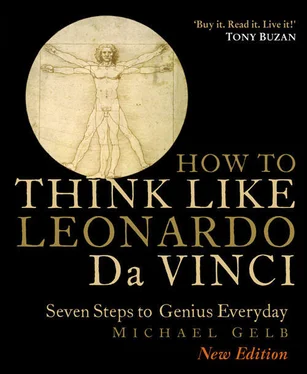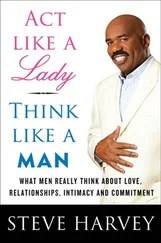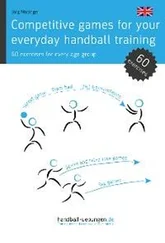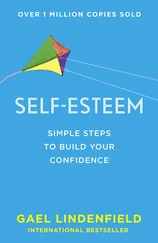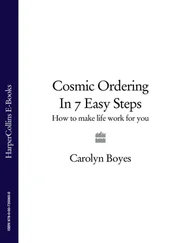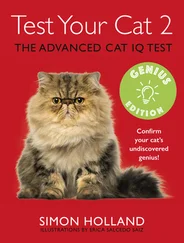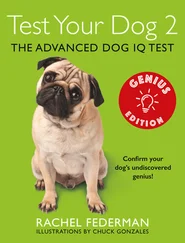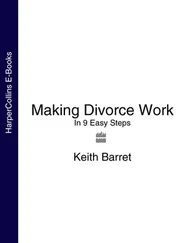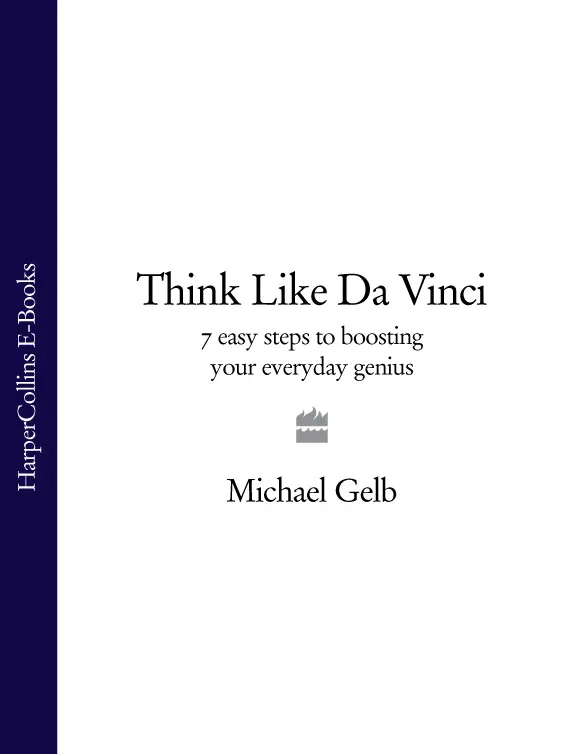

7 EASY STEPS TO BOOSTING YOUR EVERYDAY GENIUS

This book is dedicated tothe Da Vincian Spirit manifested inthe life and work of Charles Dent.
Cover
Title Page
Dedication
Preface: “Born of the Sun”
Preface to the New Edition
PART ONE
Introduction: Your Brain Is Much Better than You Think
Learning from Leonardo
A Practical Approach to Genius
The Renaissance, Then and Now
The Life of Leonardo da Vinci
Major Accomplishments
PART TWOThe Seven Da Vincian Principles
Curiosità
Dimostrazione
Sensazione
Sfumato
Arte/Scienza
Corporalita
Connessione
Conclusion: Leonardo’s Legacy
PART THREE
The Beginner’s da Vinci Drawing Course
Leonardo Da Vinci Chronology: Life and Times
Recommended Reading
List of Illustrations
Acknowledgments
About the Author
Copyright
About the Publisher
Preface: “Born of the Sun”
Think of your greatest heroes and heroines, your most inspirational role models. Maybe, if you are very lucky, the list includes your mom or dad. Perhaps you are most inspired by great figures from history. Immersing yourself in the life and work of great artists, leaders, scholars, and spiritual teachers provides rich nourishment for the mind and heart. Chances are, you picked up this book because you recognize Leonardo as an archetype of human potential and you are intrigued by the possibility of a more intimate relationship with him.
When I was a child, Superman and Leonardo da Vinci were my heroes. While the “Man of Steel” fell by the wayside, my fascination with Da Vinci continued to grow. Then, in the spring of 1994, I received an invitation to visit Florence to speak to a prestigious and notoriously demanding association of company presidents. The group chairman asked, “Could you prepare something for our members on how to be more creative and balanced, personally and professionally? Something that will point them in the direction of becoming Renaissance men and women?” In a heartbeat I responded with my dream: “How about something on thinking like Leonardo da Vinci?”
It was not an assignment I could take lightly. My students would already have paid substantial fees to attend the six-day “university,” one of several opportunities the society offers its members each year to meet in the world’s great cities to explore history, culture, and business while pursuing personal and professional development. Given the chance to choose among several concurrent classes – mine was running at the same time as five others, including one taught by former Fiat president Giovanni Agnelli – members were invited to rate each speaker on a scale of one to ten and were encouraged to walk out of any presentation they didn’t like. In other words, if they don’t like you, they chew you up and spit you out!
Despite my lifelong fascination with my new topic, I knew I had work to do. In addition to intensive reading, my preparation included a Da Vinci pilgrimage, beginning with a visit to Leonardo’s Portrait of Ginevra De’ Benci at the National Gallery in Washington, D.C. In New York, I caught up with the traveling “Codex Leicester” exhibit sponsored by Bill Gates and Microsoft. Then to London to see the manuscripts in the British Museum, The Virgin and Child with St. Anne at the National Gallery, and to the Louvre in Paris to spend a few days with Mona Lisa and St. John the Baptist. The highlight of this pilgrimage, however, was visiting the château of Cloux near Amboise, where Da Vinci spent the last few years of his life. The château is now a Da Vinci museum, with amazing replicas of some of Leonardo’s inventions crafted by engineers from IBM. Walking the grounds that he walked, sitting in his study and standing in his bedroom, looking out his window, seeing the view that he gazed at every day, I felt my heart overflow with awe, reverence, wonder, sadness, and gratitude.
Of course, I went on to visit Florence, where, eventually, I gave my talk to the presidents. The fun began when the person introducing me confused her notes on my biography with the paper I had submitted on Da Vinci. She said – and I am not, to quote Dave Barry, making this up – “Ladies and gentlemen, I am extremely privileged today to introduce to you an individual whose background surpasses anything I have ever encountered: anatomist, architect, botanist, city planner, costume and stage designer, chef, humorist, engineer, equestrian, inventor, geographer, geologist, mathematician, military scientist, musician, painter, philosopher, physicist and raconteur … Ladies and gentlemen, allow me to present … Mr. Michael Gelb!”
Ah, if only …
Well, the talk was a success (no one walked out), and it gave birth to the book you hold in your hands.
Before that unforgettable introduction, one of the members approached me and said, “I don’t believe that anyone can learn to be like Leonardo da Vinci, but I’m going to your lecture anyway.” You may be thinking something similar: Is the premise of this book that every child is born with the capacities and gifts of Leonardo da Vinci? Does the author really believe that we can all be geniuses of Da Vinci’s stature? Well, actually, no. Despite decades devoted to discovering the full scope of human potential and how to awaken it, I side with Da Vinci’s disciple Francesco Melzi, who wrote on the occasion of the maestro’s death: “The loss of such a man is mourned by all, for it is not in the power of Nature to create another.” As I learn more about Da Vinci, my sense of awe and mystery multiplies. All great geniuses are unique, and Leonardo was, perhaps, the greatest of all geniuses.
But the key question remains, Can the fundamentals of Leonardo’s approach to learning and the cultivation of intelligence be abstracted and applied to inspire and guide us toward the realization of our own full potential?
Of course, my answer to this question is: Yes! The essential elements of Leonardo da Vinci’s approach to learning and the cultivation of intelligence are quite clear and can be studied, emulated, and applied.
Is it hubris to imagine that we can learn to be like the greatest of all geniuses? Perhaps. It’s better to think of his example guiding us to be more of what we truly are.
This is a guidebook, inspired by one of history’s great souls, for that journey. An invitation to breathe the vivid air, to feel the fire in your heart’s centre, and the full flowering of your spirit.
Michael J. Gelb
January 1998
Preface to the New Edition
On July 15, 2003, I had the delightful opportunity to speak with the audience at the 2nd Stage Theater in New York City following a sold-out performance of Mary Zimmerman’s brilliant play The Notebooks of Leonardo da Vinci. One of the questions from the audience may reflect something in your mind as you hold this book in your hands: “How can the scope and depth of Leonardo’s genius be understood and why does his influence seem to be growing?”
Читать дальше
